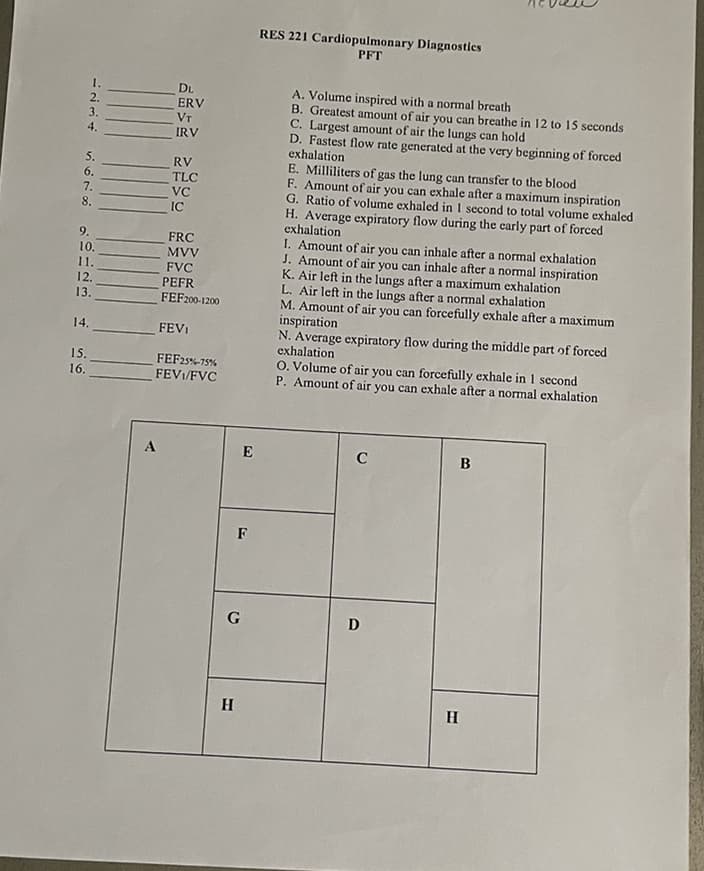1234 1. 2. 3. 4. 5. 6. 7. 8. 9. 10. 11. 12. 13. 15. 16. 14. DL ERV VT IRV RV TLC VC IC FRC MVV FVC PEFR FEF200-1200 FEVI FEF25%-75% FEV₁/FVC E F A. Volume inspired with a normal breath B. Greatest amount of air you can breathe in 12 to 15 seconds C. Largest amount of air the lungs can hold D. Fastest flow rate generated at the very beginning of forced exhalation E. Milliliters of gas the lung can transfer to the blood F. Amount of air you can exhale after a maximum inspiration G. Ratio of volume exhaled in 1 second to total volume exhaled H. Average expiratory flow during the early part of forced exhalation I. Amount of air you can inhale after a normal exhalation J. Amount of air you can inhale after a normal inspiration K. Air left in the lungs after a maximum exhalation L. Air left in the lungs after a normal exhalation M. Amount of air you can forcefully exhale after a maximum inspiration N. Average expiratory flow during the middle part of forced exhalation O.Volume of air you can forcefully exhale in 1 second P. Amount of air you can exhale after a normal exhalation C B
1234 1. 2. 3. 4. 5. 6. 7. 8. 9. 10. 11. 12. 13. 15. 16. 14. DL ERV VT IRV RV TLC VC IC FRC MVV FVC PEFR FEF200-1200 FEVI FEF25%-75% FEV₁/FVC E F A. Volume inspired with a normal breath B. Greatest amount of air you can breathe in 12 to 15 seconds C. Largest amount of air the lungs can hold D. Fastest flow rate generated at the very beginning of forced exhalation E. Milliliters of gas the lung can transfer to the blood F. Amount of air you can exhale after a maximum inspiration G. Ratio of volume exhaled in 1 second to total volume exhaled H. Average expiratory flow during the early part of forced exhalation I. Amount of air you can inhale after a normal exhalation J. Amount of air you can inhale after a normal inspiration K. Air left in the lungs after a maximum exhalation L. Air left in the lungs after a normal exhalation M. Amount of air you can forcefully exhale after a maximum inspiration N. Average expiratory flow during the middle part of forced exhalation O.Volume of air you can forcefully exhale in 1 second P. Amount of air you can exhale after a normal exhalation C B
Related questions
Question
Please solve theses questions

Transcribed Image Text:1.
2.
3.
5.
6.
7.
8.
9.
10.
11.
12.
13.
14.
15.
16.
A
DL
ERV
VT
IRV
RV
TLC
VC
IC
FRC
MVV
FVC
PEFR
FEF200-1200
FEVI
FEF25%-75%
FEV₁/FVC
G
H
E
F
RES 221 Cardiopulmonary Diagnostics
PFT
A. Volume inspired with a normal breath
B. Greatest amount of air you can breathe in 12 to 15 seconds
C. Largest amount of air the lungs can hold
D. Fastest flow rate generated at the very beginning of forced
exhalation
E. Milliliters of gas the lung can transfer to the blood
F. Amount of air you can exhale after a maximum inspiration
G. Ratio of volume exhaled in 1 second to total volume exhaled
H. Average expiratory flow during the early part of forced
exhalation
I. Amount of air you can inhale after a normal exhalation
J. Amount of air you can inhale after a normal inspiration
K. Air left in the lungs after a maximum exhalation
L. Air left in the lungs after a normal exhalation
M. Amount of air you can forcefully exhale after a maximum
inspiration
N. Average expiratory flow during the middle part of forced
exhalation
O. Volume of air you can forcefully exhale in 1 second
P. Amount of air you can exhale after a normal exhalation
C
D
B
H
Expert Solution
This question has been solved!
Explore an expertly crafted, step-by-step solution for a thorough understanding of key concepts.
Step by step
Solved in 3 steps
